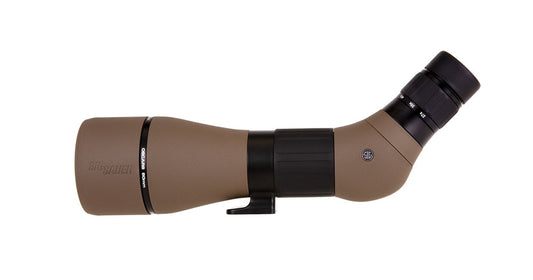

SIG SAUER Oscar 8 Spot Scope 27-55x80mm SOO82001 offers a versatile magnification range of 27-55x, ideal for long-range observation and precision shooting. Equipped with an advanced HDX optical system, this spotting scope provides enhanced clarity and brightness in various lighting conditions, making it suitable for both wildlife observation and competitive shooting. The use of extra-low dispersion glass and fully multi-coated lenses ensures that every detail is crystal clear, reducing color fringing and enhancing detail, even at extended distances.
Constructed with durability in mind, the Oscar 8 features robust FDE rubber armor for a non-slip grip and waterproof capability up to one meter. Its lightweight design, weighing just 4.25 lbs, makes it easy to transport during outdoor adventures. A rotating tripod collar and adjustable eyecups enhance user comfort, ensuring a pleasant viewing experience during extended periods of use. For those serious about optics, the SIG SAUER Oscar 8 delivers reliable performance in any situation.
Features:
- PREMIUM OPTICS for exceptional clarity and brightness in every condition.
- WATERPROOF DESIGN ensures reliability in wet environments.
- ROTATING TRIPOD COLLAR allows for seamless adjustments and stability.
- ADJUSTABLE EYECUPS provide comfort and versatility for all users.
- LIGHTWEIGHT BUILD at only 4.25 lbs, easy to carry during long outings.
- FULLY MULTI-COATED LENSES enhance light transmittance for brighter images.
- EXTRA-LOW DISPERSION GLASS reduces color fringing and enhances detail.
- DURABLE RUBBER ARMOR offers superior grip and shock resistance.
Technical Specifications Table
| Specification | Details |
|---|---|
| Magnification Range | 27-55x |
| Lens Diameter | 80mm |
| Weight | 4.25 lbs |
| Close Focus Range | 5 m |
| Eye Relief | 17-16 mm |
| Field of View | 105-73 ft @ 1000 yds |
| Scope Finish | FDE |
| Warranty | SIG SAUER's INFINITE Guarantee |
What’s in the Box?
- Oscar 8 Spotting Scope
- Fitted Neoprene Cover
- Lens Covers
- Tripod Collar
Customer Reviews
"Incredible optical quality! The clarity is unmatched for the price." - Alex R.
"Perfect for long-range spotting; worth every penny!" - Jamie T.
FAQ
1. How does the Oscar 8 compare to other spotting scopes? The Oscar 8 stands out with its superior HDX optical system, making it a preferred choice among those seeking high-performance long-range optics. Its durable and waterproof design also offers additional benefits in various weather conditions.
2. Is the Oscar 8 easy to maintain? Yes, the fully multi-coated lenses are relatively easy to clean. Regular maintenance with a soft cloth and lens cleaner is recommended to keep it in top shape.
3. What is the warranty on the Oscar 8? The SIG SAUER Oscar 8 comes with SIG SAUER's INFINITE Guarantee, ensuring your investment is protected for life.
Similar Models
Looking for additional options? Explore our extensive SIG SAUER lineup, including models like the SIG SAUER KILO 2400 for a perfect rangefinder experience and the SIG SAUER Tango 6 for versatile magnification. Discover our full collection of premium optics tailored to your shooting needs.
You May Also Like
Here’s some of our most similar products people are buying. Click to discover trending style.






